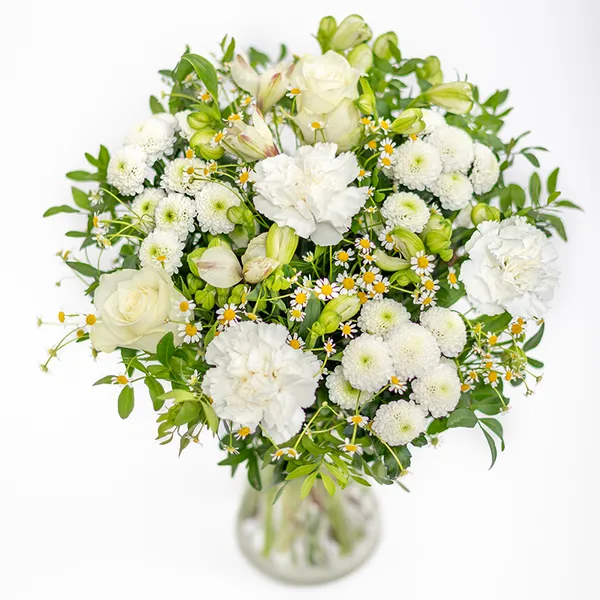Daisy: The Flower of Simplicity and Innocence
Daisies are cherished for their cheerful look and association with purity, innocence, and new beginnings. Featuring white petals around a yellow centre, they symbolise positivity and are popular in spring and summer arrangements. Thriving in meadow-like settings, they evoke natural beauty and freedom. Their bright, modest charm makes them a favourite for joyful, simple celebrations.
COMMON NAME
Daisy
BOTANICAL NAME
Bellis perennis (common daisy), Leucanthemum vulgare (oxeye daisy)
ORIGIN
Europe and temperate regions of Asia
PEOPLE ALSO CALL IT
Lawn Daisy, English Daisy, Oxeye Daisy
FLOWERING TIME
Spring through summer
ASPECT
Full sun to partial shade
SYMBOLISM
Purity, innocence, new beginnings, cheerfulness
Care Tips for Cut Daisies
Trim the Stems: Cut the stems at an angle before placing them in a vase to promote water absorption.
Remove Submerged Leaves: Strip any leaves that would sit below the waterline to prevent decay and bacteria growth.
Change Water Regularly: Replace the water every two to three days to keep the daisies fresh and prolong their bloom time.
Use Flower Food: Add floral preservative to help nourish the flowers and maintain their vitality.
Keep in a Bright Spot: Place the daisies in a bright location, but avoid direct sunlight and heat, which can cause them to wilt quickly.
Symbolism & Meaning
Daisies symbolise purity, innocence, and fresh beginnings, making them ideal flowers for weddings, baby showers, and spring celebrations. They are often associated with childhood and playfulness, reflecting their simple and joyful nature. The classic white petals of the daisy with its bright yellow centre evoke a sense of clarity and optimism, reminding us of sunny days and carefree times.
Frequently Asked Questions About Amaryllis
Seed Propagation: Daisies primarily propagate through seeds. They produce small, lightweight seeds that are easily dispersed by wind, animals, or water. These seeds can germinate and grow new plants, often resulting in a spread across lawns or open areas.
Vegetative Propagation: Daisies can also propagate vegetatively through their roots. They develop small, shallow root systems that allow them to spread across the ground, forming new plants from existing ones. This vegetative method helps them create dense clusters in favourable environments.
Self-Seeding: Daisies are prolific self-seeders, meaning that they often drop their seeds close to the parent plant. This self-seeding nature makes them easy to propagate without any intervention.
Compacted Soil: If daisies are growing abundantly, it could indicate that the soil is compacted. Daisies are resilient plants that thrive in compacted or disturbed soils where grass might struggle to grow. Aerating the soil can improve the grass’s growth and reduce daisy spread.
Low Nutrient Levels: Daisies often grow well in lawns with low fertility. If daisies dominate your lawn, it could be a sign that the soil lacks essential nutrients, such as nitrogen, which is crucial for healthy grass growth. Applying a balanced lawn fertiliser can help improve the nutrient levels and promote grass health.
Poor Lawn Density: A lawn with thin or sparse grass coverage is more prone to weed invasion, including daisies. Ensuring a thick and well-maintained grass cover by overseeding and proper lawn care can reduce the occurrence of daisies.
Blooming Season: Daisies typically bloom from early spring (March) through late autumn (October), depending on the climate. In mild climates, they can even bloom year-round.
Optimal Conditions: Daisies prefer cool, mild weather and can bloom continuously when conditions are favourable. They are hardy flowers that can thrive in both full sun and partial shade, making them resilient bloomers in various settings.




